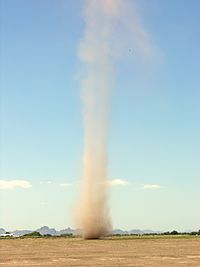
Photo from wikipedia
Eastward airmass transport from the Asian summer monsoon (ASM) anticyclone in the upper troposphere and lower 20 stratosphere (UTLS) often involves eastward shedding vortices, which can cover most of the… Click to show full abstract
Eastward airmass transport from the Asian summer monsoon (ASM) anticyclone in the upper troposphere and lower 20 stratosphere (UTLS) often involves eastward shedding vortices, which can cover most of the Japanese archipelago. We investigated the aerosol characteristics of these vortices by analysing data from two lidar systems in Japan, at Tsukuba (36.1°N, 140.1°E) and Fukuoka (33.55°N, 130.36°E), during the summer of 2018. We observed several events with enhanced particle signals at Tsukuba at 15.5-18 km altitude (at or above the local tropopause) during August-September 2018, with a backscattering ratio of ~1.10 and particle depolarization of ~5% (i.e., not spherical, but more spherical than ice crystals). These 25 particle characteristics may be consistent with those of solid aerosol particles, such as ammonium nitrate. Each event had a timescale of a few days. During the same study period, we also observed similar enhanced particle signals in the lower stratosphere at Fukuoka. The upper troposphere is often covered by cirrus clouds at both lidar sites. Backward trajectory calculations for these sites for days with enhanced particle signals in the lower stratosphere and days without indicate that the former airmasses originated within the ASM anticyclone, and the latter more from edge regions. Reanalysis carbon-monoxide 30 and satellite water-vapour data indicate that eastward shedding vortices were involved in the observed aerosol enhancements. Satellite aerosol data confirm that the period and latitudinal region were free from the direct influence of documented volcanic eruptions and high latitude forest fires. Our results indicate that the Asian Tropopause Aerosol Layer (ATAL) over the ASM 2 region extends east towards Japan in association with the eastward shedding vortices, and that lidar systems in Japan can detect at least the lower stratospheric portion of the ATAL during periods when the lower stratosphere is undisturbed by volcanic 35 eruptions and forest fires. The upper tropospheric portion of the ATAL is either depleted by tropospheric processes (convection and wet scavenging) during eastward transport or is obscured by much stronger cirrus cloud signals.
Journal Title: Atmospheric Chemistry and Physics
Year Published: 2021
Link to full text (if available)
Share on Social Media: Sign Up to like & get
recommendations!